The Wild Flowers of Skopelos
Blog
For those who love Skopelos and the wildflowers of Greece
The Wild Flowers of Skopelos
Blog
For those who love Skopelos and the wildflowers of Greece
The Wildflowers of Skopelos is for those who love the island of Skopelos and the wildflowers of Greece.
There are now over 350 flowers and trees and also information on the island, its floral landscape, geology, climate, and ecological habitats.

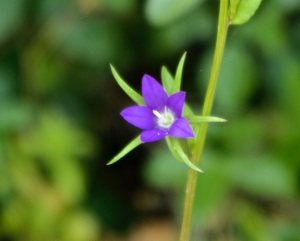
Oaks and Myths
Δρύς και Μύθοι
18 Jan 2023
The oak trees of Greece are of interest from an archaeological, mythical and ecological
as well as botanical perspective.
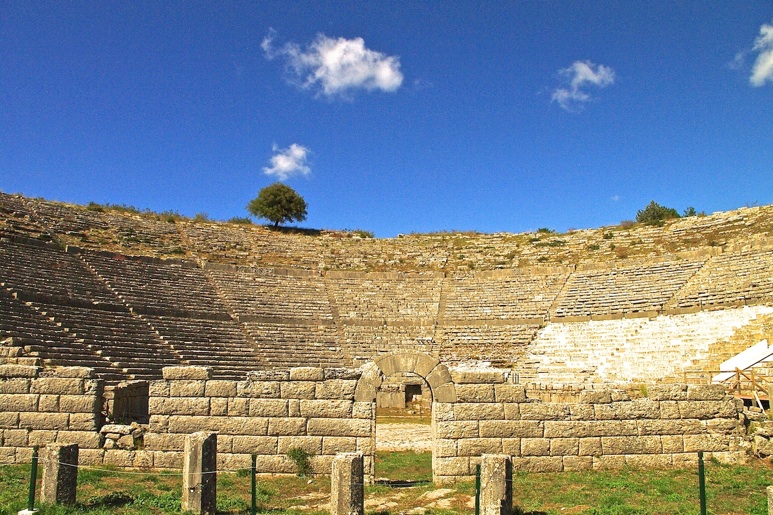
Amphitheatre at Dodoni
Mixed deciduous oak forest gradually replaced the dry grassy land (steppe) of Greece as the earth warmed after the last ice age. The woodland persisted until its gradual destruction by advancing civilisation, when trees were felled to provide building materials and fuel or burned to clear areas for developing agriculture. Some forests in Greece have survived, most notably the Foloi forest in Peloponnisos, the oak forest of Mount Athos and Sacred Groves of Zagoria. A few monumental oaks still exist, with an ancient tree at Deskati, near Grevena, which at 1,300 years is thought to be the oldest oak in Europe.
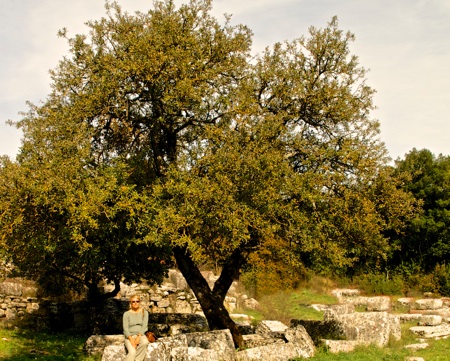
The oak replanted in the Temple of Zeus,Dodoni
Valonia oak forest was central to the silvopastoral system, which economically was important in Greece until the 20th century, with animals, mainly sheep grazing the understory beneath the open canopy of the deciduous oaks. As well as wood for fuel and timber for construction, the acorns of the valonia oak, thought to be the sweetest of all, provided for human as well as animal consumption. They were also essential to tanning leather.
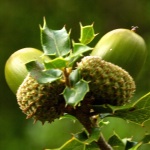
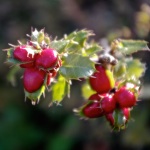
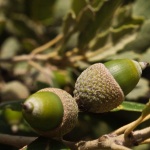
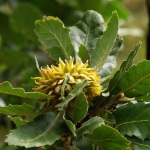
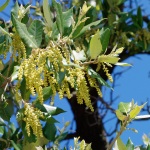
Kermes oak - acorns Kermes insects Downy oak - acorns Valonia oak - acorn Kermes oak - male flowers
Oak trees form an important part in the ecosystem of Skopelos. There are large areas of low growing kermes oak, with their prickly leaves and gnarled stems. Once important for the kermes beetles which produced scarlet dye and now valued as fodder for goats.
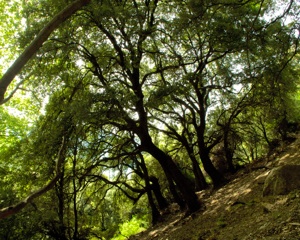
Along with other broad leaved evergreen species holm oak are an important constituent of the macchia on thePaluki peninsula, mainly as small to medium trees, but a small grove of large holm oaks also exist in this area.
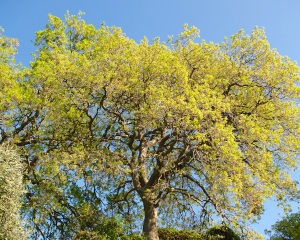
Less common on the island are downy oak, occurring as a few isolated small trees with some large trees in the Mili area.
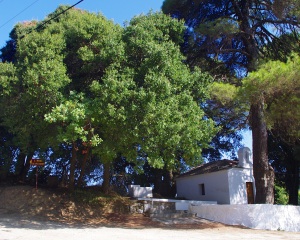
Larger specimen oak trees of all these species are often found overshadowing small chapels, including a single valonian oak creating shade above a small chapel bordering a footpath above Glyfoneri, tall kermes oak above a chapel in the Karya valley and a downy oak over a chapel in the countryside above Skopelos town.
In spring , the forest itself rested in a wintry haze,
the hamadryads in each tree dozing until dawn
dismounted her rosy throne and surrendered
to daylight.
Wings of Fury. Emily R. King.
Oak the Sacred Tree of Zeus.
The oak, named dryas (δρϋς) in ancient greek,
was a sacred tree in greek mythology.
✦The oak was the sacred to Zeus, god of the sky, god of thunder and king of the Gods of Olympus. The majestic size and strength of a mature oak was considered appropriate to Zeus as the strongest and most important god. The association was confirmed by the trees ability to withstand attack by a lightening bolt.
✦Oak groves had Dryads, who were wood nymphs, beautiful and shy; they were rarely seen by humans, but loved to dance and would join in with the revels of Dionysos. Hamadryads, were special wood nymphs, each was the spirit of a specific sacred tree, at the birth of the hamadryad her tree sprang up fully formed and she died when the tree died.
✦Dryas was the son of the Thracian king Lycurgos who strongly opposed Dionysus and expelled him from the land. In response Dionysus drove him mad and in a blind rage he chopped down his own son thinking it was a vine of ivy, the plant sacred to Dionysus. As a result of this tragedy the whole of Thrace became barren.
✦The most ancient and important sacred grove of oaks, believed to have been planted in the earliest days of creation by the Titaness Rhea, wife of Kronos and mother of Zeus. It was sited at Dodoni amongst the mountains of Thrace. By the age of the Olympian gods only one oracular tree remained at Dodoni and it was believed that Zeus and his wife Dione (not Hera) resided in the roots of the tree. Questions were put to the tree by nobles and commoners alike and responses and predictions were interpreted by priestesses from the rustling of the sacred leaves.
✦The keels of ships were made of oak and it was said that the Argos, a monoreme, which Athena helped Jason to build. A talking oak beam, from the sacred tree of Dodoni, was installed in the bow, to aid the Argonauts on their journey to recover the golden fleece.
Theophrastus states that there are five types of oak, there are four types growing on Skopelos: two evergreen species; holm or holly oak (Q. ilex) and kermes oak (Q. coccifera), and two deciduous species; downy oak (Q. Pubescens) and Valonia oak (Q. Ithaburensis ssp. macrolepsis).









Colours of Autumn
Τα Χρώματα του Φθινοπώρου
4 Nov 2022

Autumn is generally regarded as a time when nature retreats, dying back in preparation for the cold winter months, on Skopelos however autumn is a time of new growth. As the heat of summer wanes, the rains arrive and the days get shorter, the island seems to relax and celebrate the season with the emergence of new life, a second spring. The fields, dull, dry and brown in summer become lush and green again. Among the grass, in the forest and even on bare rocks a variety of colourful flowers emerge.
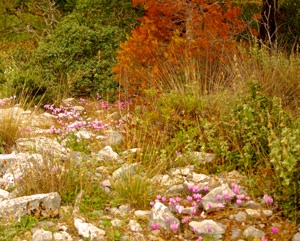
The colours of autumn, russet, amber auburn and gold, of the deciduous broad leaved trees can be seen amongst the evergreen pines and olive trees, but on Skopelos the most delightful colours of autumn are those of the wild flowers.
Cyclamens, from the palest blush to deep magenta appear on bare rock and white walls; autumn crocus, with chequered mauve and white petals, crop up around the base of tree trunks and the tiny mauve flowers of autumn squill, emerge amongst scattered brown leaves.
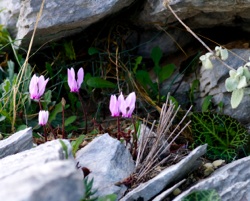
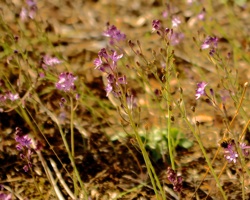
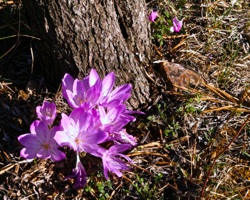
Cyclamen graecum Prospero autumnalis Colchicum binovae
Clusters of bright shiny yellow of autumn daffodils, Sternbergia lutea, make a cheerful sight and in contrast the inconspicuous pure white ladies tresses, Spiranthes spiralis, can be found amongst the grasses on the edge of the forest. and simple yellow and white daisy, Bellis sylvestris, amongst the prickly shrubs of phrygana.
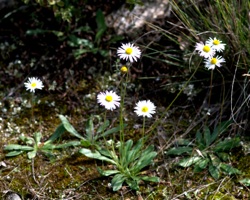
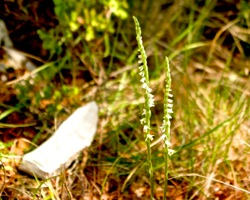
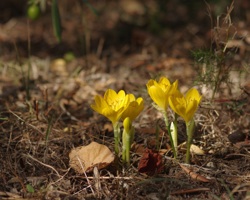
Bellis sylvestris Spranthes spiralis Sternbergia lutea
The purple heather, Erica manipuliflora, also blooms along the roadside, providing an abundance of pollen, collected by the bees for the famous Skopelos honey.
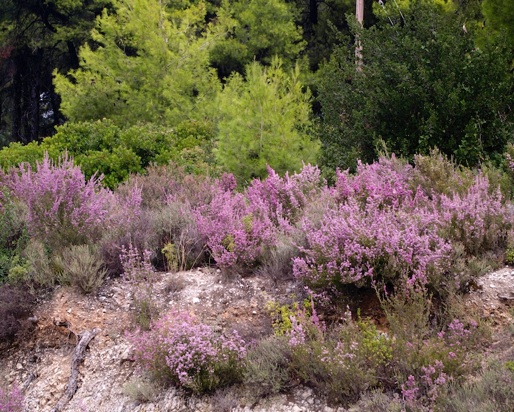
It is also the time for the reds, purples and black autumn berries and, of course, the black of olives, awaiting harvest, though not every year.
Surprisingly to those who live in Northern Europe, some trees have both flowers and fruit at the same time; Arbutus unedo creates a festive look with waxy white flowers and red or yellow berries contrasting with dark shiny green leaves.
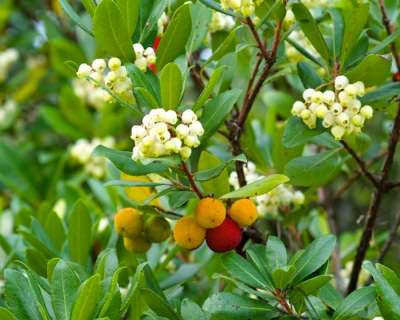
More than 350 flowers and trees